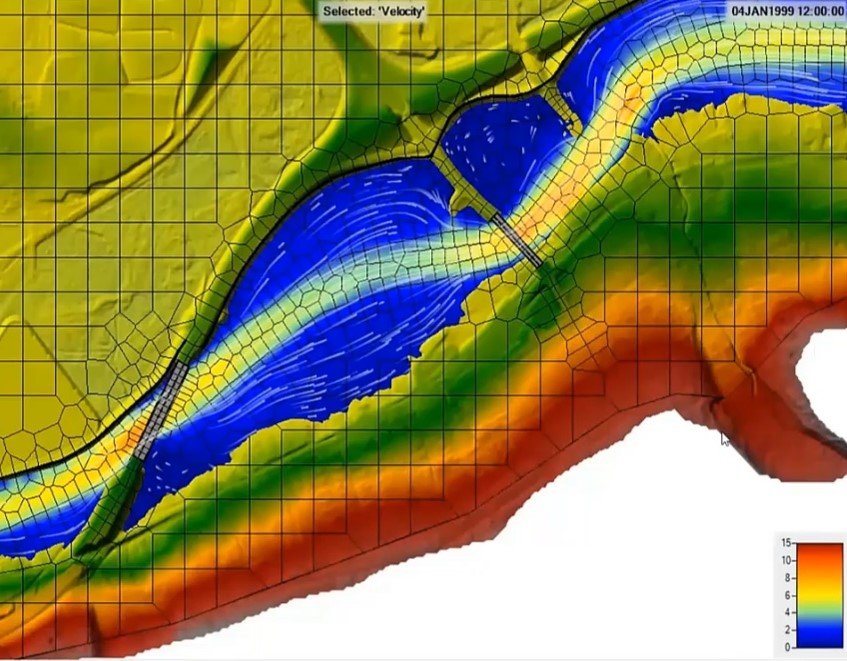Course Overview
This course offers practical hands-on training in hydraulic structure modelling using HEC-RAS. Participants will learn to simulate culverts, bridges, levees, and related components using 1D, 2D, and coupled approaches. The course covers key hydraulic principles, structural customisation, and troubleshooting techniques for accurate modelling of complex flow systems.
Learning Outcomes
In this course, you will be able to:
- Explain key hydraulic principles behind culvert and bridge modelling, including open channel flow, pressure flow, and weir flow.
- Apply 1D, 2D, and coupled 1D/2D modelling approaches to simulate culverts, bridges, levees, and related structures using HEC-RAS.
- Configure and customise structural components such as culvert inlets/outlets, bridge decks, piers, abutments, headwalls, and wingwalls.
- Interpret hydraulic parameters, rating curves, and flow separation zones to delineate ineffective flow areas and improve model accuracy.
- Troubleshoot complex structure interactions and refine model results using best-practice workflows and diagnostic tools.
Course Outline
Part 1: Culverts
Background Theory
- 1D vs 2D vs 3D approaches for modelling structures.
- Fundamentals behind open channel flow, pressure flow, and weir flow for hydraulic structures.
- Understanding weir coefficients, orifice coefficients, and head losses across structures.
- HDS5 and other sources used in HEC-RAS computations.
Workshop
- Simple pipe culvert setup in 1D.
- Simple pipe culvert setup in 2D.
- Multi-barrel culverts.
- Customising culvert inlets and outlets.
Part 2: Bridges
Background Theory
- Delineating appropriate upstream and downstream 1D cross sections for bridge modelling.
- Hydraulic table parameters and rating curves.
- Estimating flow separation and expansion/contraction zones for delineating ineffective flow areas.
- Inline structures and lateral weirs.
Workshop
- Simple bridge deck setup in 1D.
- Simple bridge deck setup in 2D.
- Dams and Inline structures.
- Levees and lateral weir setup in 1D, 2D, and coupled 1D/2D.
Part 3: Piers, Abutments, Headwalls, and Wingwalls
Background Theory
- Energy vs momentum approaches.
- Losses at piers and abutments.
- Overview of bridge scour, pipe networks, dam breach, and other HEC-RAS capabilities.
- Coupled 1D/2D modelling approaches.
Workshop
- Create a bridge structure using 1D family of rating curves.
- Create a bridge structure using 2D pressure/overtopping.
- Entering bridge details for piers and abutments.
- Troubleshooting model results.
Format
- 6+ hours of session recordings with unlimited access for 30-days.
- Pre-and-post-course materials to go through via the AWS learning platform.
- Additional resources and working model download/s.
- Ability to ask questions to the presenters at any time through the learning platform.
Pre-requisites
This advanced course requires you to understand the fundamentals of HEC-RAS, with the ability to create, run, and troubleshoot basic HEC-RAS models. For those without former HEC-RAS experience, we encourage you to register for the HEC-RAS Masterclass, to gain the required foundational knowledge.
Requirements
- A computer device.
- Windows 64-bit OS 10 or above.
- Software requirements:
Completion certification
- Participants earn CPD hours/points (i.e. with Engineers Australia) for at least 6 hours for the entire course.
- On completion of the course attendees will be issued with a Certificate of Completion.
Refund Policy
Frequent Asked Questions (FAQs)





